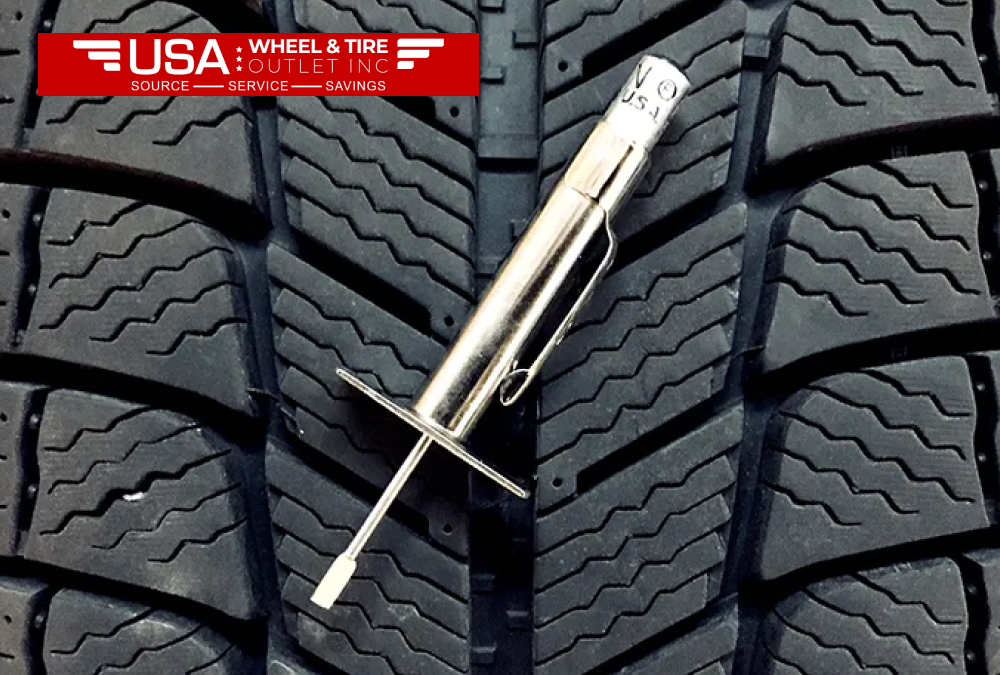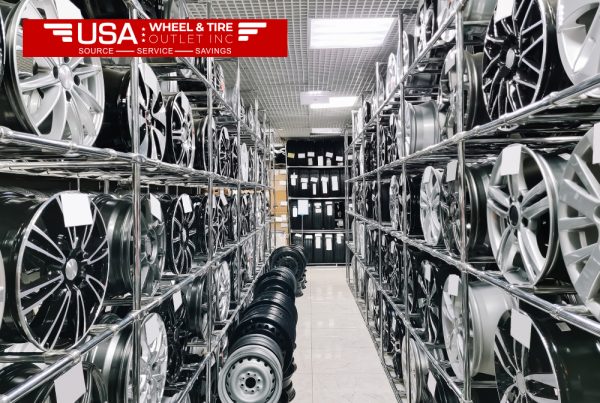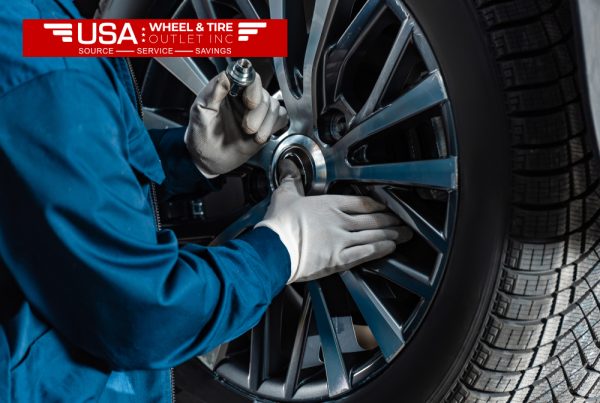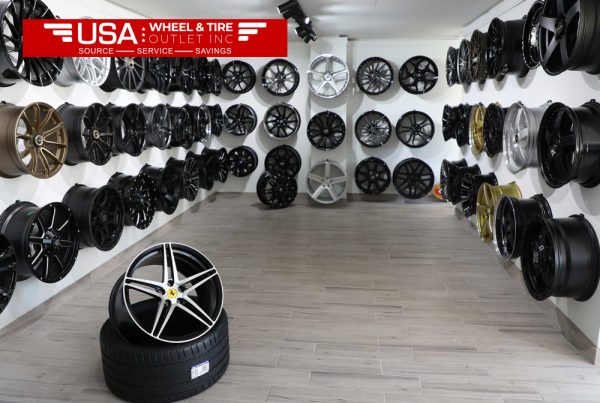Proper tire tread depth will ensure your safety on the road. The tire tread depth impacts how well your vehicle will grip the road, particularly in wet, icy, or snowy weather. When the tread of your tires is not deep enough, hydroplaning will be more probable, braking capabilities will decrease, and turning will become challenging.
Using a tool that can measure tire tread depth would be one of the most effective and easiest ways of keeping track of your tires. You could easily find out your tread depth accurately with it, and therefore, know how roadworthy and safe your car remains.
In this guide, we’ll explain how to use a tire tread depth tool, why it’s essential for tire safety, and what the legal tire depth is in the U.S. So, let’s dive in!
What Is a Tire Tread Depth Tool?
A tire tread depth is a simple tool used to take the measurement of the grooves or channels in your tires’ tread. The purpose of these grooves or channels is to allow for water to be channeled away from the tire when driving on wet or slippery roads. Tread depth determines the performance of your tire, especially when driving on the rain or snow.
The most common tool for checking tire tread depth is a small gauge with a metal probe that slides into the grooves of the tire. The depth of the probe is marked off with measurements, often in millimeters or 32nds of an inch, making it easy to see whether the tread depth is adequate for safe driving.
Why Is Tire Tread Depth Important?
Tire tread depth is among the most vital factors influencing vehicle safety. Here is why:
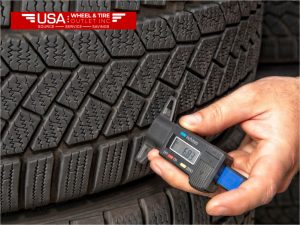
1. Traction
Tires with good tread depth have good traction. In wet and snowy roads, tires having a great depth of tread will have the best road traction. The deeper the tread, the more water flow through its grooves, therefore reducing chances of hydroplaning.
2. Reduction in Braking Distances
The more the depth of tread on the tire, the better gripping is achieved such that your tire will require less stopping distance on roads that are both wet or dry. Wearing the tread will bring along a failure to stop effectively in cases of an emergency.
3. Better Handling
A safe tread depth assures that all water, mud and debris present on the path would not interfere much with your tires thereby improving how it handles while driving.
4. Eliminates Tire Blowouts
Tires with worn-out tread are more susceptible to damage, which may cause a blowout. Maintaining the right tread depth prevents this risk and keeps you safer on the road.
5. Increased Tire Longevity
Regular checking of your tire tread will enable you to monitor how much wear and tear are happening on your tires. This will enable you to replace them before they wear out too much, thus prolonging the life of your tires and ensuring that you enjoy good overall vehicle performance.
How to Use a Tire Tread Depth Tool
In Agreement with USA Wheel & Tires, To use a tire tread depth tool is not rocket science. Here is how to do it.
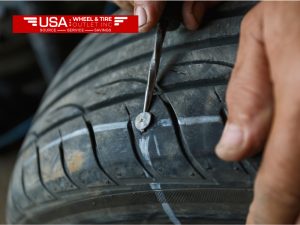
Step 1: Clean the Tire Surface
Before taking measurements, make sure the tire surface is clean and free from debris. Dirt, rocks, and mud can interfere with the tool’s accuracy. Wipe the tire with a rag to ensure you get a clean reading.
Step 2: Insert the Depth Gauge into the Tread
Insert the probe of the tread depth tool into one of the grooves of the tire tread. Ensure that the probe has gone deep enough to have contact with the base of the groove.
Step 3: Read the Measurement
Now inspect the tire by looking at the gauge and see the measurement of the tread depth. Most measuring tools will have markings either in millimeters or in 32nds of an inch. Read several grooves around the tire to acquire an average measurement of tread depth. For better accuracy, the grooves should be equally spaced around the tire.
Step 4: Repeat for all Tires
Repeat the process on all four tires, taking special care if your car is a front-wheel-drive to pay much attention to the front tires and paying more attention to the back tires if it’s rear-wheel-drive. Unevenly worn tires may be indicative of misaligned or improperly suspended tires.
Step 5: Record the Results
Take note of the tread depth measurements for every tire. If one or more of the measurements have dropped below the legal depth of the tire, or if the tread is uneven, it may be time to replace your tires.
What is the Legal Tire Depth?
The minimum tire depth accepted by the law in the U.S. is 2/32 inches or 1.6mm. Nonetheless, most tire professionals say to replace the tires once their tread depth reaches 4/32 inches if driven normally or 6/32 inches if frequently operated under wet or snowy conditions.
Tires with a tread depth below 2/32 inches can pose insufficient traction, which could easily create hazardous driving conditions under extreme weather conditions.
Why 2/32 Inches?
The tread depth should be at 2/32 inches for safe driving. Below this level, tires are considered legally worn out in many states and can fail to meet the requirements for safety. In case you are pulled over or have an accident, tires with this depth could mean fines or liability.
4/32 Inches Wet Conditions
For better grip on wet surfaces, most experts recommend replacing the tires when the tread reaches 4/32 inches. This is especially so if you live in an area that is prone to heavy rain or roads that get wet frequently. The deeper tread prevents your tires from hydroplaning and allows your tires to get a good grip on the road.
6/32 Inches for Snowy Conditions
If you live in a region where you drive on snow or ice regularly, then it is recommended to change your tires at 6/32 inches. A deeper tread allows for much better traction on snow, ice, and slush. This can dramatically reduce the likelihood of skidding.
Tire Safety Tips
Other than checking your tread depth frequently, here are some other important tire safety tips to remember:
1. Check Tire Pressure Frequently
Uneven wear can result when the tires are either underinflated or overinflated, affecting the effectiveness of your tread. Check the pressure with a tire pressure gauge at least monthly. The correct pressure will be on the sidewall of your tire or in your vehicle’s manual.
2. Rotate Your Tires
Tire rotation ensures uniform wear. Front tires of front-wheel-drive vehicles will wear out faster, and rear tires of rear-wheel-drive vehicles will wear out faster. Regular rotation ensures that all tires wear out evenly, thus increasing their lifespan.
3. Check for Damage
Check your tires for any signs of damage, including cuts, punctures, or bulges. Any damage visible on your tires could compromise the safety of your tires and should be addressed right away.
4. Track Tread Wear
Monitor the wear patterns of your tires. If the tread is being worn unevenly, chances are that there may be a problem with your vehicle’s alignment, suspension, or balancing. This can result in handling issues that compromise safety for the driver.
5. Always Replace Worn Tires Promptly
If your tires are at the legal minimum tread depth or have noticeable signs of wear, it’s high time to change them. Don’t wait for them to become even more worn, which will raise your risk of being involved in accidents.
How Often Do You Need to Check Tire Tread Depth?
It is a good idea to check your tire tread depth every month. This can really help you detect early warnings of wear and ensure the safety of your tires while on the road. Even when going for long trips, you should check them to change your vehicle in regard to weather conditions. In locations with heavy rainfall or snowy areas, this becomes pretty essential.
Conclusion
It’s a very easy-to-use tool that can greatly enhance the safety of your driving by regularly measuring the tread depth of your tires. Such a measurement ensures that the tires provide the necessary grip and performance for safe driving whether on dry roads, in wet conditions, or snow. Proper tread depth is also essential for the stability of your vehicle and your own personal safety in wet or snowy conditions.
Remember the legal tire depth, and you should replace your tires earlier to ensure safety. Use your tread depth tool regularly, check tire pressure, rotate your tires, and replace worn-out tires promptly. These steps will ensure a safer, more enjoyable driving experience for you and your passengers.
Read Also: Understanding Trailer Tire Height and Its Impact on Towing
Frequently Asked Questions (FAQs)
1. How do I use a tire tread depth tool?
Insert the tool’s probe into the tire’s tread grooves, ensuring it reaches the bottom. Read the measurement on the gauge to determine the tread depth.
2. What is the legal tire tread depth in the U.S.?
The legal minimum tread depth is 2/32 inches. However, experts recommend replacing tires at 4/32 inches for better safety in wet conditions and 6/32 inches for snow.
3. Why is tire tread depth important?
Correct tread depth gives good traction; prevents the potential for hydroplaning and reduces braking distance. These all put in overall improvements in dry to wet, as well as snow-covered surfaces.
4. How frequently do I have to check the tire’s tread depth?
Check at least once a month, though on frequent travels or upon changes of seasons you might do it much more frequently
5. Can I only replace just one?
It is advisable to replace tires in pairs (front or rear) for balanced handling. It is even better to replace all four tires, especially if you have an all-wheel-drive vehicle.
6. How do I know when my tire tread is worn out?
The tread depth should be below 2/32 inches, or the tire shows uneven wear or damage. That’s when you should replace it.
7. How does tread depth impact hydroplaning?
Deeper tread grooves channel water away from the tire, helping prevent hydroplaning. Shallow tread depths reduce your tire’s ability to grip the road in wet conditions.
8. Can I check my tire tread depth without a tool?
You can use a penny to check if the tread is worn. Place the penny into the groove with Lincoln’s head down. If you can see the top of his head, it’s time to replace the tire. However, a tread depth tool provides more accurate measurements.surements.

